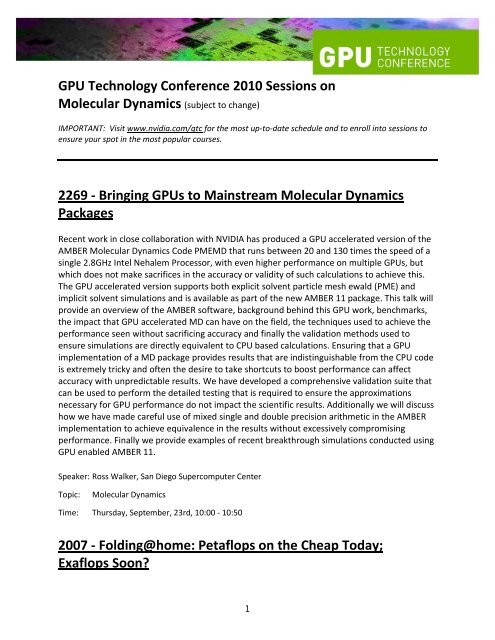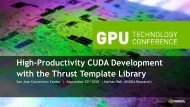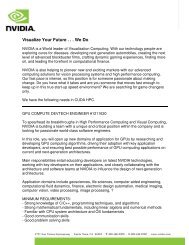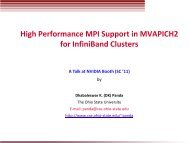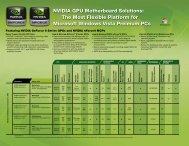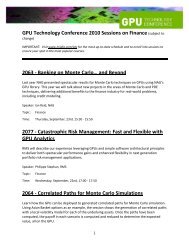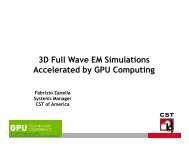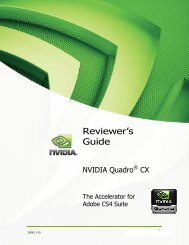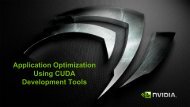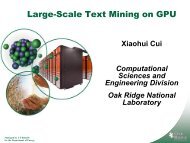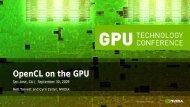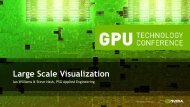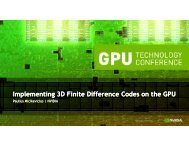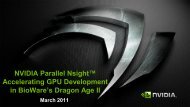Molecular Dynamics - NVIDIA
Molecular Dynamics - NVIDIA
Molecular Dynamics - NVIDIA
Create successful ePaper yourself
Turn your PDF publications into a flip-book with our unique Google optimized e-Paper software.
GPU Technology Conference 2010 Sessions on<br />
<strong>Molecular</strong> <strong>Dynamics</strong> (subject to change)<br />
IMPORTANT: Visit www.nvidia.com/gtc for the most up-to-date schedule and to enroll into sessions to<br />
ensure your spot in the most popular courses.<br />
2269 - Bringing GPUs to Mainstream <strong>Molecular</strong> <strong>Dynamics</strong><br />
Packages<br />
Recent work in close collaboration with <strong>NVIDIA</strong> has produced a GPU accelerated version of the<br />
AMBER <strong>Molecular</strong> <strong>Dynamics</strong> Code PMEMD that runs between 20 and 130 times the speed of a<br />
single 2.8GHz Intel Nehalem Processor, with even higher performance on multiple GPUs, but<br />
which does not make sacrifices in the accuracy or validity of such calculations to achieve this.<br />
The GPU accelerated version supports both explicit solvent particle mesh ewald (PME) and<br />
implicit solvent simulations and is available as part of the new AMBER 11 package. This talk will<br />
provide an overview of the AMBER software, background behind this GPU work, benchmarks,<br />
the impact that GPU accelerated MD can have on the field, the techniques used to achieve the<br />
performance seen without sacrificing accuracy and finally the validation methods used to<br />
ensure simulations are directly equivalent to CPU based calculations. Ensuring that a GPU<br />
implementation of a MD package provides results that are indistinguishable from the CPU code<br />
is extremely tricky and often the desire to take shortcuts to boost performance can affect<br />
accuracy with unpredictable results. We have developed a comprehensive validation suite that<br />
can be used to perform the detailed testing that is required to ensure the approximations<br />
necessary for GPU performance do not impact the scientific results. Additionally we will discuss<br />
how we have made careful use of mixed single and double precision arithmetic in the AMBER<br />
implementation to achieve equivalence in the results without excessively compromising<br />
performance. Finally we provide examples of recent breakthrough simulations conducted using<br />
GPU enabled AMBER 11.<br />
Speaker: Ross Walker, San Diego Supercomputer Center<br />
Topic: <strong>Molecular</strong> <strong>Dynamics</strong><br />
Time: Thursday, September, 23rd, 10:00 - 10:50<br />
2007 - Folding@home: Petaflops on the Cheap Today;<br />
Exaflops Soon?<br />
1
Learn how Folding@home has used petascale computing with GPUs to make fundamental<br />
breakthroughs in computational biology and how this technology can make an impact in your<br />
work.<br />
Speaker: Vijay Pande, Stanford University<br />
Topics: Life Sciences, Cloud Computing, High Performance Computing, <strong>Molecular</strong> <strong>Dynamics</strong><br />
Time: Thursday, September, 23rd, 11:00 - 11:50<br />
2086 - GPGPU DL_POLY<br />
Discover DL_POLY.<br />
1. DL_POLY: an MD code ICHEC has ported to CUDA. The presentation especially focuses on the<br />
auto-tuning of the work distribution between CPU and GPU<br />
Speaker: Gilles Civario, ICHEC<br />
Topics: <strong>Molecular</strong> <strong>Dynamics</strong>, High Performance Computing<br />
Time: Thursday, September, 23rd, 16:00 - 16:50<br />
2062 - HOOMD-blue: Fast and Flexible Many-Particle<br />
<strong>Dynamics</strong><br />
See the newest capabilities and performance enhancements in HOOMD-blue, a generalpurpose<br />
many-particle dynamics application written for GPUs. Speedups of 80-100x are<br />
attained for a wide range of simulation types. Topics for this presentation include an overview<br />
of HOOMD-blue, design and implementation details of the underlying algorithms, and a<br />
discussion on how generality is maintained without sacrificing performance.<br />
Speaker: Joshua Anderson, University of Michigan<br />
Topics: <strong>Molecular</strong> <strong>Dynamics</strong>, High Performance Computing, Life Sciences, Physics Simulation<br />
Time: Thursday, September, 23rd, 15:00 - 15:50<br />
2073 - High Performance <strong>Molecular</strong> Simulation, Visualization,<br />
and Analysis on GPUs<br />
This talk will present recent successes in the use of GPUs to accelerate interactive visualization<br />
and analysis tasks on desktop computers, and batch-mode simulation and analysis jobs on GPU-<br />
2
accelerated HPC clusters. We'll present Fermi-specific algorithms and optimizations and<br />
compare with those for other devices. We'll also present performance and performance/watt<br />
results for NAMD molecular dynamics simulations and VMD analysis calculations on GPU<br />
clusters, and conclude with a discussion of ongoing work and future opportunities for GPU<br />
acceleration, particularly as applied to the analysis of petascale simulations of large<br />
biomolecular complexes and long simulation timescales.<br />
Speaker: John Stone, University of Illinois at Urbana-Champaign<br />
Topics:<br />
<strong>Molecular</strong> <strong>Dynamics</strong>, Algorithms & Numerical Techniques, High Performance Computing, Life<br />
Sciences<br />
Time: Wednesday, September, 22nd, 16:00 - 16:50<br />
2128 - Hybrid Quantum Mechanics/Electrodynamics (QM/ED)<br />
Modeling of Solar Cells on a CUDA Cluster<br />
One of the greatest challenges of the twenty-first century is the utilization of renewable energy.<br />
In providing a theoretical explanation and guidelines for computer-aided design of dyesensitized<br />
solar cell (DSSC), we recently developed a hybrid multi-scale quantum<br />
mechanics/classical electrodynamics (QM/ED) methodology.<br />
Our numerical simulations were tested on a CUDA enabled Linux cluster using CP2K. We<br />
extended its CUDA implementation to MPI parallel environment. Our preliminary results<br />
demonstrated a superior performance advantage of hybrid MPI/GPGPU programming that<br />
could potentially shorten the total simulation wall time by an order of magnitude.<br />
Speaker: Hanning Chen, Northwestern University<br />
Topics: Quantum Chemistry, Energy Exploration, <strong>Molecular</strong> <strong>Dynamics</strong>, Physics Simulation<br />
Time: Wednesday, September, 22nd, 17:00 - 17:50<br />
2168 - Interactive <strong>Molecular</strong> <strong>Dynamics</strong> for Nanomechanical<br />
and Nanochemical Experiments<br />
Hear how the combination of GPU accelerated molecular dynamics simulation software, 3D TV<br />
displays, affordable haptic game controllers, and high performance molecular visualization is<br />
leading to new ways to study materials and objects on the nanoscale. We will present the<br />
concept of an appliance for integrated virtual nanoscale experiments and challenges related to<br />
software and hardware.<br />
3
Speaker: Axel Kohlmeyer, Institute for Computational <strong>Molecular</strong> Science, Temple University<br />
Topic: <strong>Molecular</strong> <strong>Dynamics</strong><br />
Time: Wednesday, September, 22nd, 10:00 - 10:50<br />
2054 - NAMD, CUDA, and Clusters: Taking GPU <strong>Molecular</strong><br />
<strong>Dynamics</strong> Beyond the Desktop<br />
A supercomputer is only as fast as its weakest link. The highly parallel molecular dynamics code<br />
NAMD was one of the first codes to run on a GPU cluster when G80 and CUDA were introduced<br />
in 2007. Now, after three short years, the Fermi architecture opens the possibility of new<br />
algorithms, simpler code, and easier optimization. Come learn the opportunities and pitfalls of<br />
taking GPU computing to the petascale.<br />
Speaker: James Phillips, University of Illinois<br />
Topics: <strong>Molecular</strong> <strong>Dynamics</strong>, High Performance Computing, Life Sciences, Physics Simulation<br />
Time: Thursday, September, 23rd, 14:00 - 14:50<br />
2218 - Redesigning <strong>Molecular</strong> <strong>Dynamics</strong> for GPUs and GPU<br />
Clusters<br />
Generalized Born and Particle Mesh Ewald (PME) molecular dynamics are two computationally<br />
intensive algorithms for simulating biological molecules. While several adaptations of<br />
Generalized Born have attained excellent speedup on GPUs, high performance Particle Mesh<br />
Ewald has been more elusive. Here we describe in detail a recent port of PME implemented<br />
within AMBER 11 that has achieved performance on par with up to 128 nodes of a top ten<br />
supercomputer.<br />
Speaker: Scott Le Grand, <strong>NVIDIA</strong><br />
Topics:<br />
<strong>Molecular</strong> <strong>Dynamics</strong>, Algorithms & Numerical Techniques, High Performance Computing, Life<br />
Sciences<br />
Time: Wednesday, September, 22nd, 15:00 - 15:50<br />
2006 - Short-Range <strong>Molecular</strong> <strong>Dynamics</strong> on GPU<br />
Learn how to accelerate short-range molecular dynamics using CUDA C. We will cover building<br />
the neighbor list and calculating the forces on the GPU. To handle the case where a few<br />
particles have significantly more neighbors than most other particles, we propose a hybrid data<br />
4
structure for the neighbor list that can achieve a good balance between performance and<br />
storage efficiency. A CUDA C implementation of the technique for Leonard-Jones forces can be<br />
found in the LAMMPS molecular dynamics open source code.<br />
Speaker: Peng Wang, <strong>NVIDIA</strong><br />
Topic: <strong>Molecular</strong> <strong>Dynamics</strong><br />
Time: Wednesday, September, 22nd, 17:00 - 17:50<br />
2035 - Simulations of Large Membrane Regions<br />
Learn how to study membrane-bound protein receptors by moving beyond the current stateof-the-art<br />
simulations that only consider small patches of physiological membranes. Towards<br />
this end, this session presents how to apply large-scale GPU-enabled computations of extended<br />
phospholipid bilayer membranes using a GPU code based on the CHARMM force field for MD<br />
simulations. Our code enables fast simulations of large membrane regions in NVT and NVE<br />
ensembles and includes different methods for the representation of the electrostatic<br />
interactions, i.e., reaction force field and Ewald summation (PME) methods. Performance and<br />
scientific results for dimyristoylphosphatidylcholine (PC) based lipid bilayers are presented.<br />
Speakers:<br />
Michela Taufer, University of Delaware, Narayan Ganesan, University of Delaware, Sandeep<br />
Patel, University of Delaware<br />
Topics: <strong>Molecular</strong> <strong>Dynamics</strong>, High Performance Computing, Physics Simulation<br />
Time: Wednesday, September, 22nd, 11:30 - 11:50<br />
5


